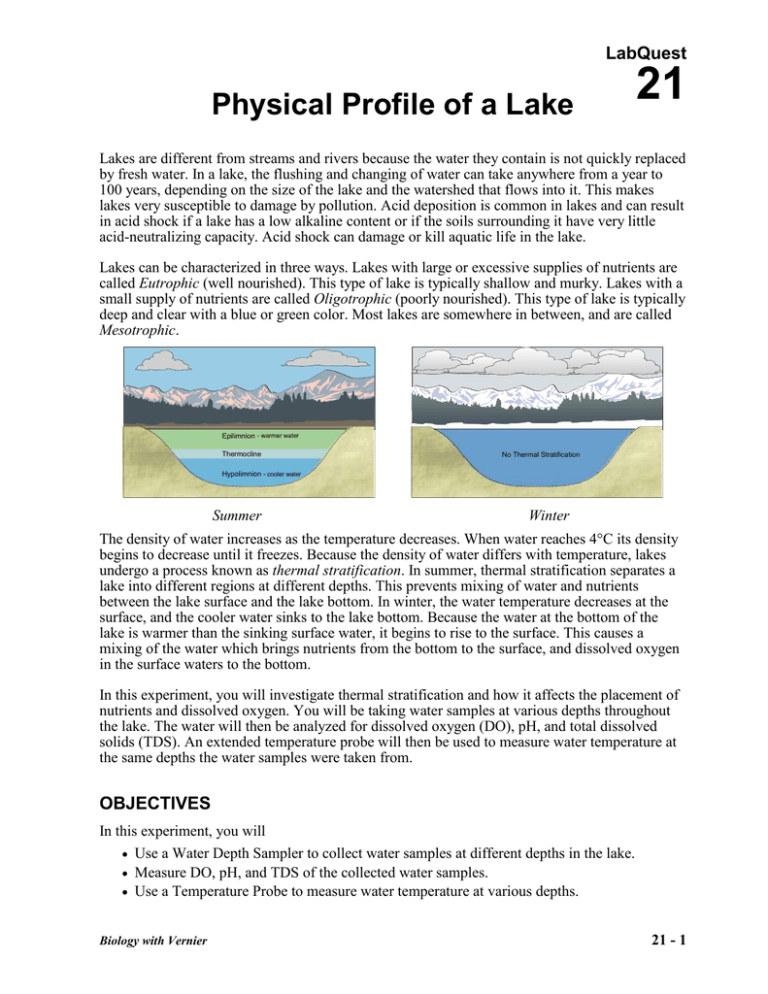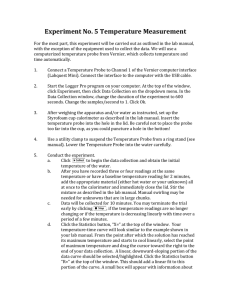21 Physical Profile of a Lake LabQuest
advertisement

LabQuest Physical Profile of a Lake 21 Lakes are different from streams and rivers because the water they contain is not quickly replaced by fresh water. In a lake, the flushing and changing of water can take anywhere from a year to 100 years, depending on the size of the lake and the watershed that flows into it. This makes lakes very susceptible to damage by pollution. Acid deposition is common in lakes and can result in acid shock if a lake has a low alkaline content or if the soils surrounding it have very little acid-neutralizing capacity. Acid shock can damage or kill aquatic life in the lake. Lakes can be characterized in three ways. Lakes with large or excessive supplies of nutrients are called Eutrophic (well nourished). This type of lake is typically shallow and murky. Lakes with a small supply of nutrients are called Oligotrophic (poorly nourished). This type of lake is typically deep and clear with a blue or green color. Most lakes are somewhere in between, and are called Mesotrophic. Epilimnion - warmer water Thermocline No Thermal Stratification Hypolimnion - cooler water Summer Winter The density of water increases as the temperature decreases. When water reaches 4°C its density begins to decrease until it freezes. Because the density of water differs with temperature, lakes undergo a process known as thermal stratification. In summer, thermal stratification separates a lake into different regions at different depths. This prevents mixing of water and nutrients between the lake surface and the lake bottom. In winter, the water temperature decreases at the surface, and the cooler water sinks to the lake bottom. Because the water at the bottom of the lake is warmer than the sinking surface water, it begins to rise to the surface. This causes a mixing of the water which brings nutrients from the bottom to the surface, and dissolved oxygen in the surface waters to the bottom. In this experiment, you will investigate thermal stratification and how it affects the placement of nutrients and dissolved oxygen. You will be taking water samples at various depths throughout the lake. The water will then be analyzed for dissolved oxygen (DO), pH, and total dissolved solids (TDS). An extended temperature probe will then be used to measure water temperature at the same depths the water samples were taken from. OBJECTIVES In this experiment, you will Use a Water Depth Sampler to collect water samples at different depths in the lake. Measure DO, pH, and TDS of the collected water samples. Use a Temperature Probe to measure water temperature at various depths. Biology with Vernier 21 - 1 LabQuest 21 MATERIALS LabQuest LabQuest App Vernier Dissolved Oxygen Probe Vernier pH Sensor Vernier Conductivity Probe Vernier Extra Long Temperature Probe Water Depth Sampler 1 L water sampling bottle D.O. calibration bottle PRE-LAB PROCEDURE Important: Prior to each use, the Dissolved Oxygen Probe must warm up for a period of 10 minutes as described below. If the probe is not warmed up properly, inaccurate readings will result. Perform the following steps to prepare the Dissolved Oxygen Probe. 1. Prepare the Dissolved Oxygen Probe for use. a. b. c. d. e. Remove the protective cap. Unscrew the membrane cap from the tip of the probe. Using a pipet, fill the membrane cap with 1 mL of DO Electrode Filling Solution. Carefully thread the membrane cap back onto the electrode. Place the probe into a 250 mL beaker containing distilled water. Remove membrane cap Add electrode filling solution Replace membrane cap Figure 1 2. Set the switch on the Conductivity Probe box to 0–200 µS/cm. Connect the Dissolved Oxygen Probe, pH Sensor, and Conductivity Probe to LabQuest. Choose New from the File menu. If you have older sensors that do not auto-ID, manually set up the sensors. 3. It is necessary to warm up the Dissolved Oxygen Probe for 5–10 minutes before taking readings. With the probe still in the distilled water beaker, wait 5–10 minutes while the probe warms up. The probe must stay connected at all times to keep it warmed up. If disconnected for a period longer than 5 minutes, it will be necessary to repeat this step. 4. Calibrate the Dissolved Oxygen Probe. If your instructor directs you to use the stored calibration, proceed directly to Step 5. If your instructor directs you to manually enter the calibration values, choose Calibrate►Dissolved Oxygen from the Sensors menu. Tap Equation. Enter the values for the Slope and the Intercept. Select Apply to make the changes take effect and select OK. Proceed directly to Step 5. If your instructor directs you to perform a new calibration, continue with this step to calibrate your sensor. 21 - 2 Biology with Vernier Physical Profile of a Lake Zero-Oxygen Calibration Point a. Choose Calibrate►Dissolved Oxygen from the Sensors menu. b. Select Calibrate Now. c. Remove the probe from the water bath and place the tip of the probe into the Sodium Sulfite Calibration Solution. Important: No air bubbles can be trapped below the tip of the probe or the probe will sense an inaccurate dissolved oxygen level. If the voltage does not rapidly decrease, tap the side of the bottle with the probe to dislodge the bubble. The readings should be in the 0.2 to 0.6 V range. d. Enter 0 as the known value in mg/L for Reading 1. e. When the voltage stabilizes (~1 minute), tap Keep. Insert probe at an angle Submerge probe tip 1-2 cm Figure 2 Saturated DO Calibration Point f. Rinse the probe with distilled water and gently blot dry. g. Unscrew the lid of the calibration bottle provided with the probe. Slide the lid and the grommet about ½ inch onto the probe body. Screw lid and probe back onto bottle Insert probe into hole in grommet 1 cm of water in bottom h. i. j. k. l. Figure 3 Add water to the bottle to a depth of about ¼ inch and screw the bottle into the cap, as shown. Important: Do not touch the membrane or get it wet during this step. In the Reading 2 field, enter the correct saturated dissolved-oxygen value (in mg/L) from Table 3 (for example, 8.66) using the current barometric pressure and air temperature values. If you do not have the current air pressure, use Table 4 to estimate the air pressure at your altitude. Keep the probe in this position for about a minute. The readings should be above 2.0 V. When the voltage reading stabilizes, tap Keep. Select OK. Prepare the probe for transport by filling the calibration bottle half full with water. Secure the Dissolved Oxygen Probe far enough down in the bottle that the membrane is completely covered by water. Screw the calibration bottle lid completely onto the bottle so that no water will leak out. Biology with Vernier 21 - 3 LabQuest 21 PROCEDURE When measuring at different depths in a lake or pond, it is best to choose a sampling site as far from shore as possible. This will generally require a boat or other form of floating vessel to reach the site. Once at the site proceed to Step 5. Part I: Measuring Dissolved Oxygen, pH, and Total Dissolved Solids (TDS) 5. Rinse the sampling bottle a few times with lake water. 6. Arm the water sampler by doing the following: a. At each end of the water sampler, there is a small metal tube with two holes cut out. Take hold of the metal tubes and pull the balls at each end of the tube outward at the same time. b. Slip the two metal tubes together and align the holes. c. Insert the metal trigger pin attached to the rope through the aligned holes of the two metal tubes. The water sampler is now armed. You can now let go of the metal tubes and they will stay in place due to the trigger pin. Rope line Trigger Pin Ball Metal tubes Ball Water sampler body 7. Test the water sampler. a. Take hold of the rope 1.5 m up from the sampler. Figure 4 b. Place the sampler and slack rope in the water. Lower the armed water sampler to a depth of 1.5 m Important: Provide plenty of slack rope when lowering the sampler in the water. It is best to take hold of the rope at the depth you will be sampling and place the slack rope in the water with the water sampler. c. Give the rope line two quick tugs upward. At a 1.5 m depth you should be able to see the sampler trigger and the balls pop into place at each end of the sampler tube. d. Empty the water from the sampler and rearm it. 8. Lower the water sampler to the bottom depth you are going to be measuring. Remember to provide plenty of slack rope when lowering the water sampler. 9. Allow the water sampler to remain at that depth for 1 minute. Trigger the sampler with two quick tugs upward on the rope line. Pull the sampler up into the boat. Push forward to open Figure 5 10. Empty the water from the sampler using the clear plastic tubing connected to the bottom of the sampler. Hold the sampler at an angle of 30° with the clear plastic tubing pushed down into your sampling bottle. Minimize the introduction of oxygen into the sample by tipping the sampling bottle at an angle and letting the water pour down the inside wall of the bottle. Water will flow from the tubing when the white plastic stop valve is opened (see Figure 5). 21 - 4 Biology with Vernier Physical Profile of a Lake 11. Measure dissolved oxygen, pH, and conductivity of your water sample. Place only one probe in the water sample at a time. a. Remove the dissolved oxygen probe from its storage bottle. Place the tip of the probe into the water sample and gently swirl to allow water to move past the probe’s tip. CAUTION: Do not submerge the Dissolved Oxygen Probe beyond the tip. The handle is not waterproof. b. Monitor the readings displayed on the screen. When the reading is stable, record the dissolved oxygen concentration in Table 1. Remove the probe from the water sample and place it back into the storage bottle. c. Remove the pH probe from its storage bottle. Rinse the probe tip with lake water. Place the tip of the probe into the water sample. CAUTION: Do not submerge the pH Sensor beyond the tip. The handle is not waterproof. d. Monitor the pH readings. Record the pH in Table 1 when the reading has stabilized. Remove the probe from the water sample and place it back into the storage bottle. e. Place the tip of the Conductivity Probe into the water sample. CAUTION: Do not submerge the Conductivity Probe beyond the tip. The handle is not waterproof. f. Monitor the conductivity readings for 1 minute. Record the concentration of total dissolved solids in Table 1. Remove the probe from the water sample. 12. Repeat Steps 8–11 every 1.5 m up from the first sample taken. The final measurement should be taken just below the surface. Part II: Measuring Water Temperature 13. Disconnect all probes from LabQuest and put them away. Connect the Extra Long Temperature Probe. Choose New from the File menu and manually set up the sensor. 14. Set up the data-collection mode. a. On the Meter screen, tap Mode. Change the data-collection mode to Events with Entry. b. Enter the Name (Depth) and Units (m). Select OK. 15. Start data collection. 16. Measure the water temperature at various depths. a. Lower the temperature probe to the bottom depth you will be measuring. Be sure to always maintain a solid grip on the cable. Do not support the cable by holding the amplifier box. Depending on how much weight has been added to the end of the temperature probe cable, the probe could disconnect from the amplifier box and sink to the bottom of the lake. b. Monitor the readings. When the reading has stabilized, tap Keep. c. Enter the depth the temperature probe is at in meters and select OK to store the data pair. 17. Repeat Step 16 at each of the same depths samples were taken in Part I. 18. Stop data collection. 19. Examine the data on the displayed graph of temperature vs. depth. To examine the data pairs on the displayed graph, tap any data point. As you tap each data point, the temperature and depth values of each data point are displayed to the right of the graph. Record the temperature at each depth in Table 1. 20. Disconnect the temperature probe and put it away. Biology with Vernier 21 - 5 LabQuest 21 DATA Table 1 Depth (m) Dissolved Oxygen (mg/L) pH Total Dissolved Solids (mg/L) Temperature (°C) 0 1.5 3.0 4.5 6.0 7.5 9.0 10.5 12.0 13.5 15.0 PROCESSING THE DATA 1. Plot a graph containing the following plots. The depth should be plotted along the x-axis and the measurements collected along the y-axis. Dissolved oxygen vs. depth Conductivity vs. depth pH vs. depth Temperature vs. depth QUESTIONS 1. Using your measurements, is there any evidence of thermal stratification in the lake you investigated? Explain. 2. A thermocline is the region where water temperature changes rapidly with depth. Was there evidence of a thermocline? If so, at what depth was it apparent? 3. How would you expect the temperature measurements to change if you repeated the measurements during a different season? 21 - 6 Biology with Vernier Physical Profile of a Lake 4. How did the dissolved oxygen levels change as the depth changed? How does this relate to thermal stratification? 5. Based on your results, at what depth would you expect to find most of the aquatic life? 6. Was there evidence of a thermocline? If so, at what depth was it apparent? 7. Would you classify this lake as oligotrophic, eutrophic, or mesotrophic? 8. Describe what happened to the pH measurements as depth changed? Did you notice any kind of pattern? Explain. 9. Describe what happened to the concentration of total dissolved solids as depth changed? Is there any pattern? Explain. Biology with Vernier 21 - 7 LabQuest 21 CALIBRATION TABLES Table 2: 100% Dissolved Oxygen Capacity (mg/L) 770 mm 760 mm 750 mm 740 mm 730 mm 720 mm 710 mm 700 mm 690 mm 680 mm 670 mm 660 mm 0°C 1°C 2°C 3°C 4°C 5°C 6°C 7°C 8°C 9°C 10°C 11°C 12°C 13°C 14°C 15°C 16°C 17°C 18°C 19°C 20°C 21°C 22°C 23°C 24°C 25°C 26°C 27°C 28°C 29°C 30°C 14.76 14.38 14.01 13.65 13.31 12.97 12.66 12.35 12.05 11.77 11.50 11.24 10.98 10.74 10.51 10.29 10.07 9.86 9.67 9.47 9.29 9.11 8.94 8.78 8.62 8.47 8.32 8.17 8.04 7.90 7.77 14.57 14.19 13.82 13.47 13.13 12.81 12.49 12.19 11.90 11.62 11.35 11.09 10.84 10.60 10.37 10.15 9.94 9.74 9.54 9.35 9.17 9.00 8.83 8.66 8.51 8.36 8.21 8.07 7.93 7.80 7.67 14.38 14.00 13.64 13.29 12.96 12.64 12.33 12.03 11.74 11.46 11.20 10.94 10.70 10.46 10.24 10.02 9.81 9.61 9.41 9.23 9.05 8.88 8.71 8.55 8.40 8.25 8.10 7.96 7.83 7.69 7.57 14.19 13.82 13.46 13.12 12.79 12.47 12.16 11.87 11.58 11.31 11.05 10.80 10.56 10.32 10.10 9.88 9.68 9.48 9.29 9.11 8.93 8.76 8.59 8.44 8.28 8.14 7.99 7.86 7.72 7.59 7.47 13.99 13.63 13.28 12.94 12.61 12.30 12.00 11.71 11.43 11.16 10.90 10.65 10.41 10.18 9.96 9.75 9.55 9.35 9.16 8.98 8.81 8.64 8.48 8.32 8.17 8.03 7.89 7.75 7.62 7.49 7.36 13.80 13.44 13.10 12.76 12.44 12.13 11.83 11.55 11.27 11.01 10.75 10.51 10.27 10.04 9.83 9.62 9.42 9.22 9.04 8.86 8.69 8.52 8.36 8.21 8.06 7.92 7.78 7.64 7.51 7.39 7.26 13.61 13.26 12.92 12.59 12.27 11.96 11.67 11.39 11.11 10.85 10.60 10.36 10.13 9.90 9.69 9.48 9.29 9.10 8.91 8.74 8.57 8.40 8.25 8.09 7.95 7.81 7.67 7.54 7.41 7.28 7.16 13.42 13.07 12.73 12.41 12.10 11.80 11.51 11.23 10.96 10.70 10.45 10.21 9.99 9.77 9.55 9.35 9.15 8.97 8.79 8.61 8.45 8.28 8.13 7.98 7.84 7.70 7.56 7.43 7.30 7.18 7.06 13.23 12.88 12.55 12.23 11.92 11.63 11.34 11.07 10.80 10.55 10.30 10.07 9.84 9.63 9.42 9.22 9.02 8.84 8.66 8.49 8.33 8.17 8.01 7.87 7.72 7.59 7.45 7.33 7.20 7.08 6.96 13.04 12.70 12.37 12.05 11.75 11.46 11.18 10.91 10.65 10.39 10.15 9.92 9.70 9.49 9.28 9.08 8.89 8.71 8.54 8.37 8.20 8.05 7.90 7.75 7.61 7.48 7.35 7.22 7.10 6.98 6.86 12.84 12.51 12.19 11.88 11.58 11.29 11.01 10.75 10.49 10.24 10.00 9.78 9.56 9.35 9.14 8.95 8.76 8.58 8.41 8.24 8.08 7.93 7.78 7.64 7.50 7.37 7.24 7.11 6.99 6.87 6.76 12.65 12.32 12.01 11.70 11.40 11.12 10.85 10.59 10.33 10.09 9.86 9.63 9.41 9.21 9.01 8.82 8.63 8.45 8.28 8.12 7.96 7.81 7.67 7.52 7.39 7.26 7.13 7.01 6.89 6.77 6.66 Table 3: Approximate Barometric Pressure at Different Elevations 21 - 8 Elevation (m) Pressure (mm Hg) Elevation (m) Pressure (mm Hg) Elevation (m) Pressure (mm Hg) 0 760 800 693 1600 628 100 748 900 685 1700 620 200 741 1000 676 1800 612 300 733 1100 669 1900 604 400 725 1200 661 2000 596 500 717 1300 652 2100 588 600 709 1400 643 2200 580 700 701 1500 636 2300 571 Biology with Vernier




